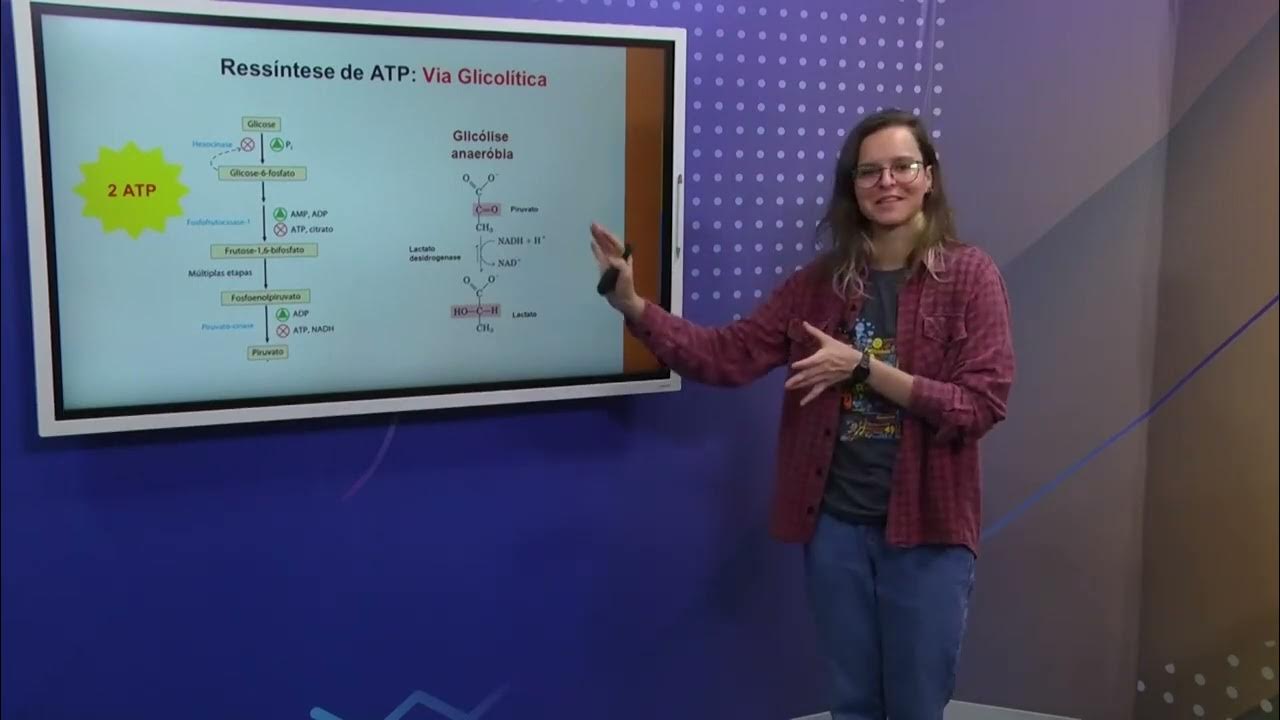Cellular Respiration
Summary
TLDRThis video provides a detailed explanation of ATP synthesis in the body, focusing on oxidative phosphorylation and substrate-level phosphorylation. It outlines the three phases of cellular respiration: glycolysis, the Krebs cycle, and the electron transport chain. The process of oxidative phosphorylation within the mitochondria, which generates the majority of ATP, is explained in-depth, including how protons move across membranes to create kinetic energy, powering ATP synthesis. The video also discusses glycolysis and the Krebs cycle, highlighting the importance of NADH and FADH2 in electron transport, ultimately fueling ATP production and energy storage.
Takeaways
- 😀 Oxidative phosphorylation and substrate-level phosphorylation are the two primary ways ATP is synthesized in the body.
- 😀 Cellular respiration consists of three phases: glycolysis, the Krebs cycle (KB cycle), and the electron transport chain (ETC)/oxidative phosphorylation.
- 😀 Oxidative phosphorylation occurs in the mitochondria, utilizing proton gradients to generate ATP via ATP synthase.
- 😀 The electron transport chain pumps hydrogen ions into the intermembrane space, creating a proton gradient that drives ATP production.
- 😀 NADH and FADH2, generated from glycolysis and the Krebs cycle, shuttle electrons to the electron transport chain to fuel the proton pumping process.
- 😀 Energy from electrons passed through protein complexes in the ETC is used to actively transport hydrogen ions into the intermembrane space.
- 😀 Glycolysis takes place in the cytoplasm and does not require oxygen. It produces 2 net ATP molecules, 2 NADH molecules, and 2 pyruvate molecules from one glucose molecule.
- 😀 The Krebs cycle, occurring in the mitochondrial matrix, processes pyruvate into acetyl-CoA, which is used to produce 3 NADH, 1 FADH2, 1 ATP, and 2 CO2 per cycle.
- 😀 The breakdown of glucose through glycolysis and the Krebs cycle generates essential molecules (NADH, FADH2) for ATP production in oxidative phosphorylation.
- 😀 Oxygen is crucial for the electron transport chain to function, as it acts as the final electron acceptor, pulling electrons through the chain.
- 😀 In the absence of oxygen, pyruvate is converted to lactic acid via fermentation, a process separate from the aerobic stages of cellular respiration.
Q & A
What are the two main ways ATP is synthesized in the body?
-ATP is synthesized in the body primarily through two processes: oxidative phosphorylation, which occurs in the mitochondria, and substrate-level phosphorylation, which happens in the cytoplasm of cells.
What is the relationship between the electron transport chain and oxidative phosphorylation?
-The electron transport chain is a crucial part of oxidative phosphorylation. Together, they form the final phase of cellular respiration, where energy from electrons is used to pump hydrogen ions, creating a gradient that drives ATP synthesis.
Why is the mitochondria’s anatomy important in ATP synthesis?
-The mitochondria’s structure, including its outer and inner membranes, plays a key role in ATP synthesis. The intermembrane space has a high concentration of hydrogen ions, and the inner membrane contains ATP synthase, which uses the movement of these ions to produce ATP.
How do hydrogen ions contribute to ATP synthesis?
-Hydrogen ions (protons) move passively from the intermembrane space into the mitochondrial matrix through ATP synthase. The kinetic energy from this movement is used to couple a phosphate group to ADP, forming ATP.
What role does the electron transport chain play in creating hydrogen ion gradients?
-The electron transport chain pumps hydrogen ions from the mitochondrial matrix into the intermembrane space, creating a gradient. This requires energy from electrons, which are passed between protein complexes in the chain.
What are NADH and FADH2, and how do they contribute to cellular respiration?
-NADH and FADH2 are molecules that carry high-energy electrons from glycolysis and the Krebs cycle to the electron transport chain. These electrons are crucial for powering the movement of hydrogen ions, which creates the gradient necessary for ATP synthesis.
What is the primary function of the Krebs cycle in ATP production?
-The primary function of the Krebs cycle is not to directly produce large amounts of ATP, but to generate NADH and FADH2, which carry electrons to the electron transport chain for ATP production. It also produces one ATP per cycle.
Why does the cell need to maintain hydrogen ion gradients?
-Maintaining hydrogen ion gradients is essential for ATP synthesis. Without a high concentration of hydrogen ions in the intermembrane space, ATP synthase would not be able to harness kinetic energy to produce ATP.
What is the significance of oxygen in the electron transport chain?
-Oxygen is the final electron acceptor in the electron transport chain. It pulls electrons through the chain, allowing the system to continue functioning. Without oxygen, the chain would stop, and ATP production would cease.
How does glycolysis differ from oxidative phosphorylation in terms of ATP production?
-Glycolysis produces only 2 net ATP molecules per glucose molecule, whereas oxidative phosphorylation can generate up to 34 ATP molecules. Glycolysis does not require oxygen and occurs in the cytoplasm, whereas oxidative phosphorylation happens in the mitochondria and depends on oxygen.
Outlines

This section is available to paid users only. Please upgrade to access this part.
Upgrade NowMindmap

This section is available to paid users only. Please upgrade to access this part.
Upgrade NowKeywords

This section is available to paid users only. Please upgrade to access this part.
Upgrade NowHighlights

This section is available to paid users only. Please upgrade to access this part.
Upgrade NowTranscripts

This section is available to paid users only. Please upgrade to access this part.
Upgrade Now5.0 / 5 (0 votes)





